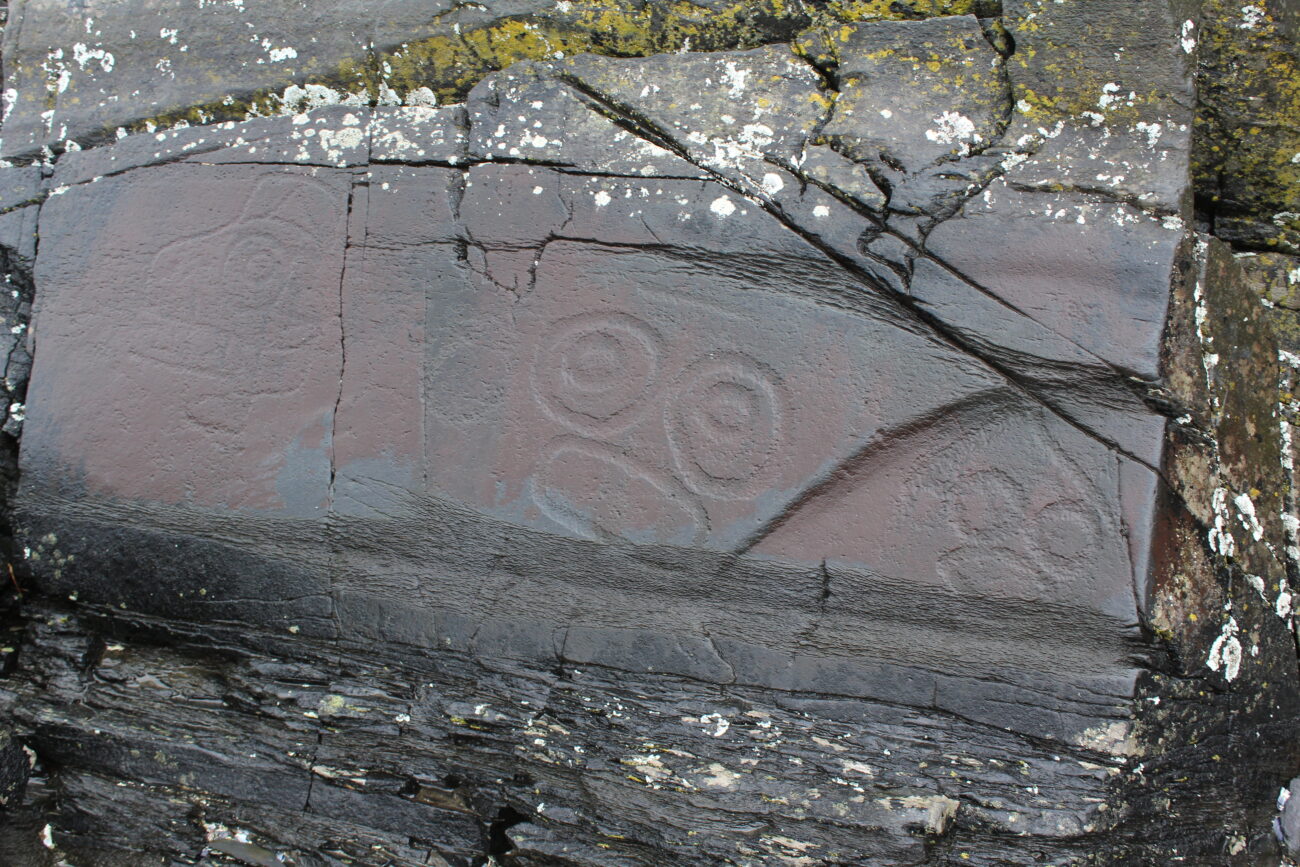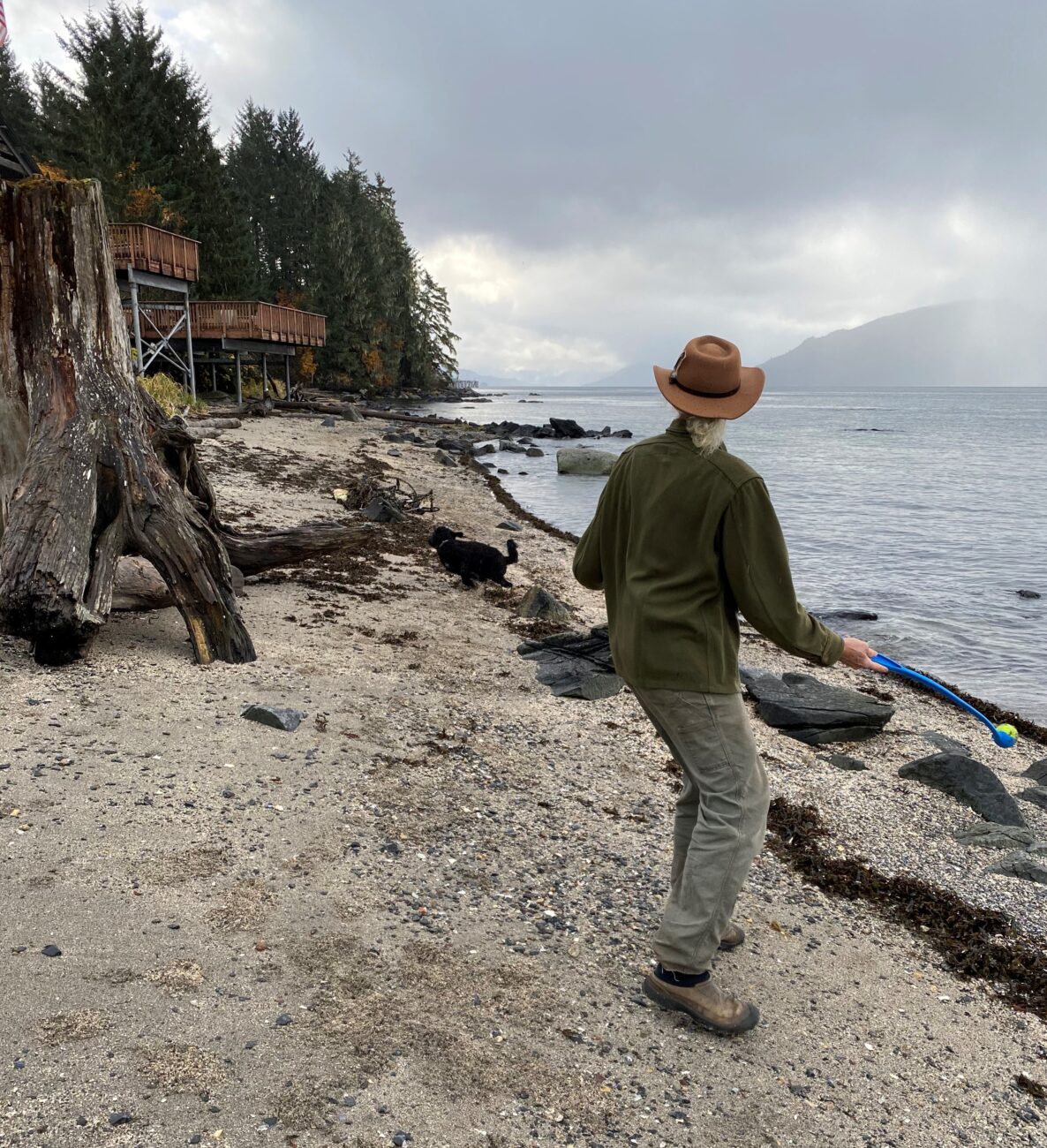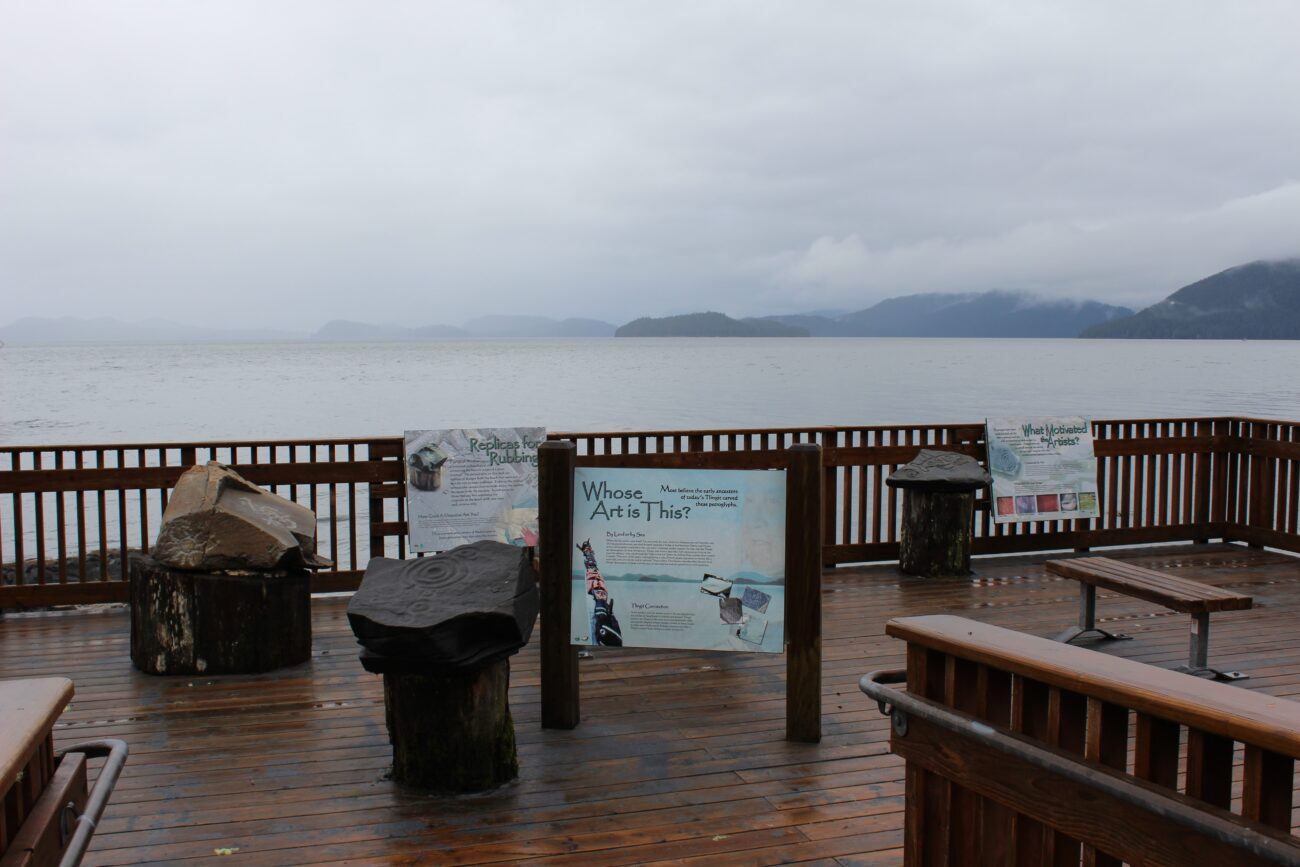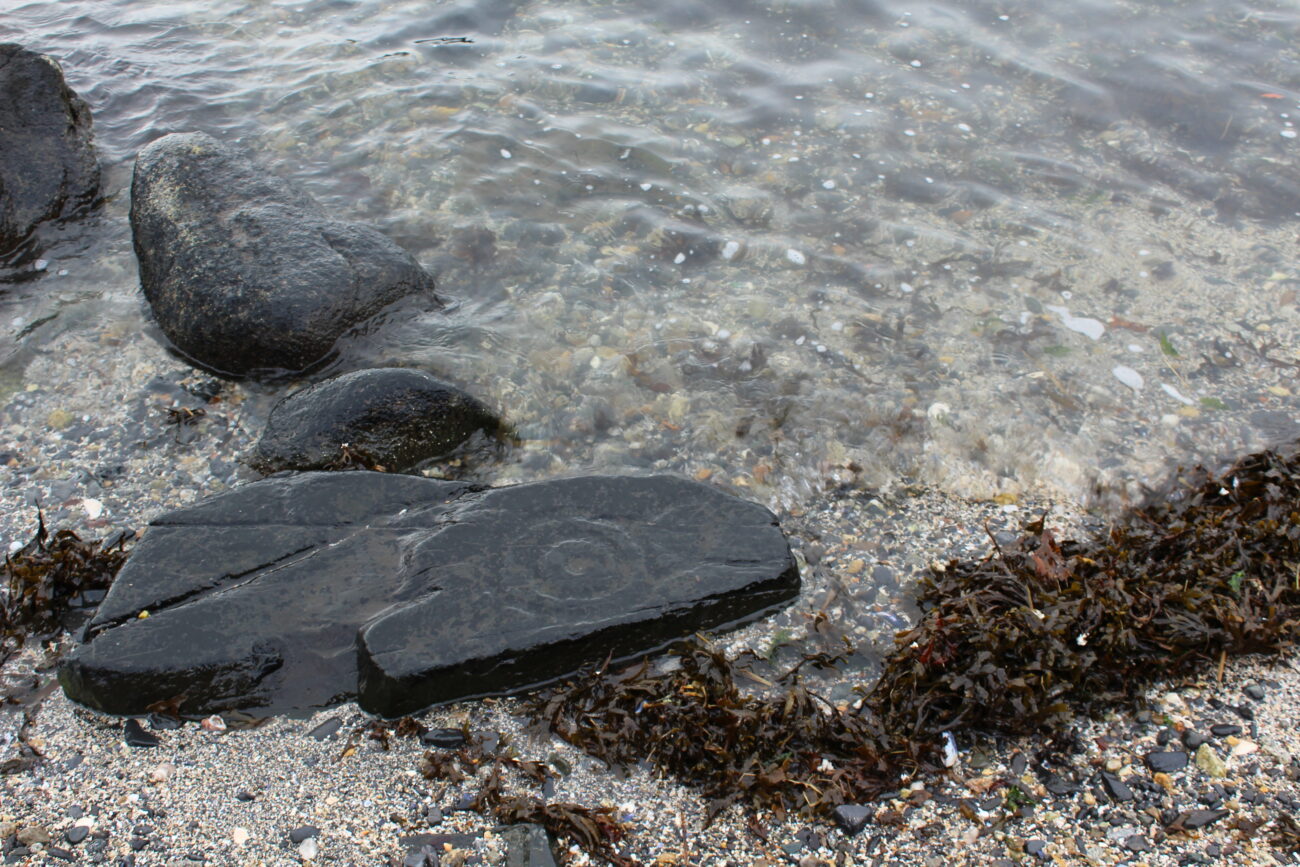
(Sage Smiley / KSTK)
A beach on the northern tip of Wrangell Island is home to rock carvings estimated to be at least 8,000 years old — petroglyphs made by the ancestors of Wrangell’s Tlingit people. Recently, one of the larger petroglyphs seemed to change color — and ignited some debate in town. Is it vandalism? Or naturally-occurring?
While most of the carvings on Wrangell’s Petroglyph Beach are the weathered grey of boulders in a tidal zone, one of the largest intact rocks appears a deeply pigmented red-brown, especially when wet. A dinner-plate-sized animal figure with a fin adorns the left side of the rock face. Two similarly-sized faces with round, wide eyes and open oval mouths are carved to its right — all stained.

(Sage Smiley / KSTK)
“We always come down here for our dog walks, morning and evening. So I’ve gotten pretty familiar with all the petroglyphs. It’s fun looking at them in different light and whatnot,” says Wrangell resident Dan Trail. “We,” is Trail and Dougie, his curly-haired black poodle-Portuguese water dog-mix.
“The other day when I was looking at it it was just like wow, somebody poured paint on this thing,” Trail says, explaining why he recently posted a photo on social media, alleging the burnt-sienna color was vandalism. A fiery discussion ensued on Wrangell’s community Facebook page.
“I mean, I don’t care if it’s a different color,” Trail says, “Just the fact that it looks like paint.”
Trail says despite all the time he and Dougie spend down at Petroglyph Beach, he’d never noticed color like that on the carvings before. Plus, it was isolated to just the one large slab: “I haven’t seen it on any of the other petroglyphs.”
Wrangell police investigated. Police Chief Tom Radke says it was puzzling.
“We went out and looked at it and felt it and touched it and it doesn’t — It seems weird, don’t get me wrong, but it doesn’t seem like it’s paint like we know it as paint,” Radke says. For one thing, the petroglyph is at least a hundred feet from the stairs down to the beach.
“Where the couple of them are — Where the one is, I can’t imagine anybody bringing paint all the way out there,” Radke explains, “And number two, it’s been really rainy. I mean, not exactly painting weather.”
Ultimately, Radke says the police don’t think it was recent vandalism. More likely it’s tannins, a natural pigment that also gives the water around muskegs that coffee color.
Trail isn’t totally convinced: the discoloration is uneven. He gestures to the slab of rock: “This is splotchy, it’s really obvious at the bottom end of the mouth there, there’s nothing and just now when we were looking at it, you can see it’s rubbed off there. And that would make sense because that’s the part that’s protruding, so if any logs or whatever rubbed up against it, it could take the color off.”
In the comments of Trail’s post, some Wrangellites said they believe the coloration has been around for years and posted pictures of a similar, red-brown color from 2014 and 2015.
Others say it could be vandals — but from decades past. Petroglyph Beach was made a state historic site in 2000 to protect the carvings of faces, animals, and spiral shapes. Janell Privett was on the Friends of the Wrangell Museum board at the time and recalls people messing with the 8,000-year-old petroglyphs. She says that prompted elders from Wrangell’s tribe and the Friends of the Museum to push for protections for the site.
“One of the biggest situations that happened was a tour group,” Privett recalls. “Photography, of course, has changed and changed and changed and there’s absolutely no reason for a good photographer to spray paint a petroglyph. And that has happened more than once. And the last one was a brown and another time a black.”
She thinks the color could be leftover paint from that tour group vandalism.
In a survey in the early 2000s, state archaeologists identified more than 40 ancient rock carvings on the Wrangell beach near the northern point of the island.
Tis Peterman says there used to be more. She’s a tribal citizen who says the Wrangell Cooperative Association had asked for assistance from the state to do a dig in the beach sand to catalog petroglyphs that could be buried by time, but “they turned us down flat.”
Years later, she says state Department of Natural Resources officials approached Wrangell’s tribe, soliciting help funding park improvements, which she says was frustrating, considering the lack of previous engagement.

The reddish color could also come from other wear and tear. Chalk, rice paper, and ferns were used to make rubbings of the petroglyphs for years — in fact, Wrangell’s tourism industry encouraged it as recently as the early 1990s.
KSTK sent photos of the petroglyph to chemists, geologists, and archaeologists at the University of Alaska Southeast. They’ve proposed a variety of possible natural causes for the coloring, including iron oxide or microscopic organisms. But they all agree — nothing can be determined by looking at photographs of the petroglyphs.
Biochemist Konrad Meister is an assistant professor of chemistry at UAS, based in Juneau. He says he thinks it could be some sort of bacteria.
“You might know from these very fascinating pictures from some of the national parks in the hot springs, there’s quite a lot of color variations,” Meister explains, “And so if you have microbes growing onto something, it can give it a set of those shades that you see in these images. But again, based on just this picture, it’s a bit tricky to be very conclusive about it.”
The only conclusive way to find out what’s coloring the petroglyph would be to take samples. If it’s biological, Meister said that could be as simple as bumping a culture plate up against the surface and seeing what grows.
“And that is probably the answer that the general public might be interested in,” Meister says, “But then you can go much further and say like, ‘Okay, what is actually causing the color change?’ and then we have to look into some of the chemical biochemical reactions and ‘Okay, where did it come from? Why is it only there seasonally?’”
Meister says this is a good time to be asking questions about changing color in the carvings: “There’s a lot of research going into this because a lot of times, these color changes can just be color changes. But you can also see that [change] in the deterioration of those petroglyphs. And that’s, that’s obviously something that we don’t want to happen, because they’re such amazing historical artifacts.”
Meister says he’d be interested in enlisting the help of a Wrangell UAS student, or even a science-minded high school student to look into what’s coloring Wrangell’s petroglyphs.
Whatever the color is, Peterman says Wrangell’s Petroglyph Beach is a rocky strip of refuge for her.

(Sage Smiley / KSTK)
“I get a sense of peace out there,” Peterman says. “I feel a calmness, that no matter what, we’ve been a part of this land forever. And even though looking back over the years and how the natives have been treated, good and bad. We’ve always come from here.”
Being out among the petroglyphs makes her think about the thousands of years her ancestors have lived in the area, she says: “You go up there and you just are like, ‘Wow, this is really, proof that we live in harmony with the land and water.’”
While the red tint on one of Wrangell’s petroglyphs remains a mystery, for now, the tide continues to pull and push against the ancient carvings.
Get in touch with KSTK at news@kstk.org or (907) 874-2345.












